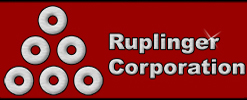Technology Tip: Primer on Sensors - part one of three
By Peter Ruplinger
Reprinted from Utah Molders Quarterly Newsletter August 2006
Every injection molder has sensors. This article series provides an overview of the different types of sensors and how they function. Be sure to read the manufacturer’s safety precautions and application guidelines.
Mechanical - These are typically called limit switches. An arm activates electrical contacts in an enclosure. The enclosure is usually Nema 12, which means it is oil tight. They are most commonly found on an injection molder’s gate. Older machines used them to trigger end of travel on the injector. Most limit switches have a pair of contacts. One set is normally open (N.O.), meaning the contact doesn’t conduct current until operated. The other set is normally closed (N.C.), meaning the contacts do conduct current until the switch is activated. Obviously when a switch is replaced the contacts need to be wired up correctly. On a wiring diagram the symbols look somewhat like a gate. When the gate is closed current passes, when its open current does not pass.
Proximity switches – are solid state. They do not make physical contact. The most common types are inductive, capacitive, and magnetic.
Inductive - Inductive sensors, sometimes called barrel sensors are used to sense metallic objects. The sensors look like a tube of lipstick with wires coming out the back end. The wider the tube, the greater the sensing distance will be. For example, a sensor with a 10mm diameter might sense a distance of 2mm. A 40mm sensor might sense a distance of 8mm. Inductive sensors are usually rated to operate on 120 volts AC or 24 volts DC. They may have wires from a N.C. contact, a N.O. contact, and a common. Some sensors have a wire designated “source”, and another designated “sink”. Source means that they switch a positive D.C. current on. Sink means that they ground a D.C. current from some device which already has a positive current provided, but won’t function until it is grounded.
If you are choosing a sensor, you may want one with a small LED pilot light on the back end. It facilitates troubleshooting.
Capacitive - Capacitive sensors look like and function similar to inductive sensors, but they are designed for non metallic objects. You will often find them on a resin hopper. They are activated by minute amounts of water in the object sensed. Therefore they work much better with some substances than others. See the manufacturer’s data sheet for performance specifications.
Magnetic - As the name suggests, magnetic sensors only sense objects made from iron. They are typically larger than other proximity switches. Because they contain no electronic components, they are considered rugged and immune to electrical spikes and noise.
Encoders - Encoders monitor shaft rotation. They typically look like a three inch metal box with a 3/8” shaft coming out one side and a set of wires coming out the other. The encoder shaft mounts with a coupler or timing belt to the shaft which is being monitored. Inside the box is a disc made of glass or polymer. If the disc is glass it has lines etched on it. As the disc rotates, the etched lines pass a small photo sensor. If the disc is a polymer, it contains minute magnetically charged particles which function as the etched lines on a glass disc. Instead of a photo-sensor, a magnetic head picks up the signals as they speed by. The sensor sends pulses to a programmable controller, electronic counter, or CPU control device. The control device counts the pulses to determine the RPM or position of the shaft. Encoders with glass shafts tend to be fragile so don’t use a hammer to mount a timing pulley on the encoder shaft.
Encoders can vary from less than a hundred to several hundred pulses per revolution. Obviously the more pulses the finer the resolution. When specifying an encoder, determine what resolution you need, and how many pulses per second your counting device can handle. You may need to use a timing pulley to gear down the encoder so it doesn’t send pulses faster than your counter can count them. If you’re using a coupler to connect the encoder shaft, make it a flexible coupler to minimize shock.
If you want to monitor the position of a shaft, install an inductive sensor to pick up the key or a lug mounted on the shaft as it rotates. The sensor will send a home signal to the counter. That way the counter can monitor the position as well as velocity of the shaft. Every time it sees a signal from the home sensor, it will reset the counter to zero.
Many encoders have a common wire and two signal wires. One signal wire monitors clockwise rotation and the other monitors counter clockwise rotation.
In part two we will discuss gray encoders, resolvers, linear transducers, and resistive sensors
Primer on Sensors - Part Two
